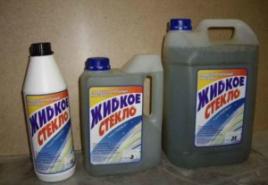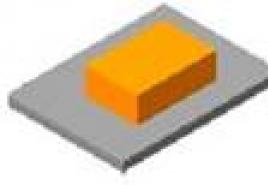Do-it-yourself wax production principles. Foundation production as a business Foundation press dadan
Wax is used to rationalize beekeeping. Thanks to its use, the productivity of the enterprise, as well as the life expectancy of bees, increases significantly. Wax is thin wax sheets with hexagonal cells that allow bees to build regular combs.
In modern honey production, a regular purchase of high-quality foundation is simply necessary. So the business of its production will be a great idea. However, in order for it to bring real income, you should purchase reliable equipment for the production of foundation. We will talk about his choice.
Wax production technology
- Melting wax. As a rule, only high-quality bee wax is used, but about 15% of industrial wax can be added to reduce the cost of the product.
- The resulting raw material is settled and filtered.
- Formation of sheets using special equipment. A foundation machine with rotating drums is used. During the formation process, the sheets are cooled with water.
- Pressing sheets to a thickness of about 1 mm.
- Imprinting with matrices.
- Cutting the finished product into sheets of the required size.
- Drying, as well as packing foundation.
Basic equipment
To organize a small business for the manufacture of foundation, you will need several special machines. The minimum production equipment includes a wax sterilizer, a roller machine, as well as a tape-forming machine equipped with a rotating drum.

If a larger production is planned, then it is best to purchase an automated line. Such equipment for the production of foundation will significantly save on personnel, because only 2-3 people can serve the line.
Its cost will depend on the manufacturer, performance, modernity and additional parameters. The minimum price for a production line is 500 thousand rubles, but as the productivity of the equipment increases, its cost increases.
Roll selection
The main equipment for the manufacture of honeycombs are rollers. They can be either electric or manual. But if you plan to produce products in large volumes, then an electric foundation press is needed. The quality of the finished product will depend on the reliability of this machine.

The equipment works on the principle of a waffle iron. The basis of the machine are metal matrices, with the help of which the wax surface is formed. The choice of a press should be based on the performance of the apparatus, the flow rate of the liquid required for its cooling, the dimensions of the installation, as well as its cost.
The market offers a wide range of imported and domestic equipment. For serious production, it is not recommended to buy Chinese machines, which fail very quickly. With a small budget of the enterprise, it is best to purchase domestic equipment, which is practically not inferior in quality to German or Swiss machines. For example, the Orenburg press for the production of foundation OIV-50 allows you to manufacture products that will meet all the requirements for hardness and elasticity.
Equipment for making foundation at home
For those who are engaged in beekeeping and constantly need foundation, the production of this product at home will be quite profitable. The fact is that for a small production, it will be enough to purchase manual or electric rollers and a sterilizer.

This will be much cheaper than buying a production line, especially if there is no demand for products in the region. At home, a waxing matrix is used, which is equipped with a water cooler.
The details of such an apparatus must be made of stainless steel with a cell surface of a special material that prevents wax from sticking to the mold. The equipment must be connected to the water supply and sanitation to make it easier to work with it.
In the event that raw materials are purchased, it is recommended to use a sterilizer that will prevent infection of bees due to low-quality wax.
Any beekeeper is well aware of what foundation is and why it is needed. Do-it-yourself foundation rollers are also familiar to those who work with bees. It is this simple device that allows you to quickly and effectively help the bees in such an important matter as building honeycombs, in which honey will subsequently accumulate.
Types of foundation and methods of its manufacture
Externally, foundation is thin sheets made on the basis of wax or other materials, on both sides of which there are extruded recesses - bottoms. The recesses on the surface of the foundation are not round - they are made in the form of a hexagon. It is this cross-sectional shape, as is known, that each cell of a honeycomb has.

Wax, depending on the material from which it is made, can be of several types:
- natural (it is this wax that the bees themselves produce, using wax for this);
- made on the basis of artificial materials, close to wax in their characteristics;
- plastic, for the manufacture of which polypropylene is most often used (plastic foundation can be used repeatedly, its service life sometimes reaches 10 years).

Since plastic foundation is still very rarely used by domestic beekeepers, it is not advisable to consider in detail in this article the nuances of its production and use.
The production of foundation, the material for the manufacture of which is wax or its artificial analogues, can be carried out according to two main methods.
- To implement the first technique, such equipment for the production of honeycombs as rollers is used, which can be equipped with drives of various types - manual, mechanical, electric, etc. The working parts of the rollers have a cellular relief. It is between them that a preheated thin sheet of wax or its artificial analogue is passed.
- The second method of making foundation involves the use of a press, which can be equipped with a manual or electric drive. The main working bodies of such a press are two plates, on the surface of which there are hexagonal protrusions. The latter form recesses in soft sheets of wax or other material. It should be noted that the press, in comparison with rollers, does not make it possible to make foundation with high productivity, therefore it is advisable to use it only in cases where a small amount of wax sheets is needed.
Foundation production with rollers
The production of foundation with the help of special rollers is a very effective method that allows you to quickly and without significant waste to produce this material in the required quantities. It is such a simple device that is most often used by those beekeepers who are not interested in purchasing ready-made material, but in making foundation at home or even in a mobile apiary. At the same time, using rollers is much more convenient and easier than using a press.

Typical structural elements of rollers, which are produced by many modern enterprises, are:
- two engraved shafts, the working surfaces of which form the foundation relief (rollers, as a rule, are made of hardened steel, and their corrugated surface, so that softened wax or its artificial analogue does not stick to it, is covered with a special polymer composition);
- two gears, with the help of which the rollers are given rotation relative to each other;
- adjusting bolts, which are necessary in order to set the required distance between the rollers;
- the base on which all the structural elements of the device are attached.
An important characteristic of the rollers, which are used to produce foundation, is the angle of the hexagonal protrusions engraved on their working part. Manufacturers try to make this angle as close as possible to the angles of the cells of the honeycombs that the bees themselves build (it is 120º).

As mentioned above, in order to make foundation, it is necessary to pass a thin sheet of wax or an artificial analogue of such material through the rollers. Do-it-yourself wax can be made both from ready-made sheets, which can be purchased separately, and from sheet material produced independently. Several methods can be used to make sheets from wax or other material.
- Glass or smooth plywood is immersed in a bath of molten wax or its equivalent. After complete solidification and cooling of the material, the sheet from it is easily separated from the base. As a rule, it is required to form a sheet of a certain thickness, for which a glass or plywood template is immersed in a bath of molten material three to four times.
- A more advanced and productive technique for manufacturing foundation sheets involves the use of a special device, the main element of which is a drum. The latter, rotating with a handle, passes through a bath of molten material. The drum of such a device has a large diameter, which is necessary so that the wax layer formed on its surface has time to completely harden and cool before it is removed.
- It is also possible to obtain a sheet of wax or other material from which foundation will be made by rolling a heated ingot of material through smooth rollers.
- It is also possible to make a sheet for the production of foundation in a simpler way, without using any special devices for this. You will need gauze and a bath in which there will be wax or its equivalent. A piece of gauze, which plays the role of a reinforcing element of the future sheet, is dipped into a bath with liquid material, and then laid on a flat and smooth surface for complete solidification and cooling. Finished sheets of wax or other material, in order for them to acquire the required strength, should be kept outdoors at room temperature. Such an exposure is necessary in order to make foundation from the resulting sheets with a minimum amount of waste.
Technology features
The rollers, with which foundation will be made, are installed in a special tray. A separating solution is poured into the bath. It is necessary so that the softened wax does not stick to the protrusions on the rollers and high-quality recesses with the required geometric parameters are formed on the surface of the sheet.
It is not difficult to make a separating solution on your own. For this, the following ingredients are used: liquid honey is full or a solution consisting of water (1 liter), unscented liquid soap (100 g) and glycerin (2 teaspoons). In such a solution, so that it forms a thin layer on the surface of the foundation with a smell that attracts bees, you can add 1 gram of a special agent containing queen bee pheromones. After the rollers are installed in a pre-prepared bath, a separating solution is poured into it.
The process of making wax is as follows.
- A sheet of wax or an artificial analogue of such material is placed in the bath.
- The sheet located on the surface of the separating liquid gently moves towards the gap between the rollers and goes into it.
- By turning the handle away from you, the rollers are rotated, at this moment the sheet is completely drawn into the gap and passed between the working surfaces of the rollers.

13.12.2016 1
Voshchina is a wax sheet, on which there are bottoms on both sides, made in the form of a hexagon. It collects honey. Consider rollers for making foundation with your own hands (drawings). It is this element that is the main component of the honeycomb. Usually the whole bee family works on its manufacture, but there is no limit to perfection!
Now people have learned to make foundation on their own. This helps to save the time of the bees. In this way, they save time on expanding their nests in spring, early summer, when they have the main honey harvest. In this case, all the attention of the bee family will be directed only to the collection of nectar.
Foundation manufacturing methods
For the manufacture of artificial foundations, you can use a material such as polypropylene. The manufacture of this honeycomb component can be done in two ways:
- Use of rollers (automatic, manual). They have a cellular relief. Wax, which is scrolled in such an apparatus, must initially be heated.
- The use of a press (electric, simple). This mechanism is represented by two plates on which hexagonal cells are applied. The performance of this method is negligible. The press is suitable for the manufacture of honeycomb elements in a small apiary.
When manufacturing, do not forget about such an important factor as thickness. The sheet should be about 1 mm (this is the size recommended by experts).
The finished product, before being placed inside the hive, must be attached to a special matrix. The matrix is represented by a frame that holds such a fragile product as foundation. It has special requirements:
- strength;
- shiny surface;
- quality (natural) material.
To make such a design that will be used by bees in building honeycombs, special equipment will be required. It is represented by rollers, which can be purchased ready-made (factory), or you can make it yourself.
Main types of equipment
There are three types of wax rollers:
- Manual rollers - this model is characterized by small dimensions. When it is installed, maintenance is almost never a problem. This equipment includes the following parts: a frame (it is represented by a massive base), feed, receiving rollers, which are connected by a chain drive, a set of clamps.
- Electric - these products are characterized by high performance. This is due to the use of an electric motor that activates an actuator that pulls the pipe through the rollers.
- Equipped with a hydraulic drive - these units are endowed with increased power. They belong to capital industrial equipment.
Of these three types of equipment, the hand model is mainly used in the manufacture of foundation. On it, the rollers are endowed with the same relief as the finished base for the honeycombs. Creating a form is not considered an entirely easy process. Wax must be heated, it is always used in liquid form. After heating, this mass is scrolled through the rollers. Having taken the necessary form, it gradually hardens.
Waxing rollers are used to roll a thin wax band from which an important element of the honeycomb is formed. Experienced beekeepers know that the width of the cells on the combs differs in different zones of the CIS, it varies between 5.12 - 5.69 mm.
For our zone, according to the measurements made by specialists, the width of the cells is 5.33 mm. If you believe the data of scientists beekeepers (and there is no reason to doubt their reliability), then bees are able to build their combs with an accuracy of 0.015 - 0.020 mm. Such data should be taken into account in the manufacture of wax rollers.
In production, three types of this equipment are usually used:
- two-roll - this model is represented by two shafts that are located in parallel. The upper shaft is characterized by a small section, this part is made of high-strength steel. The lower shaft is characterized by the presence of a section with a large diameter. For its manufacture, steel is used, which is coated with rubber;
- three-roll;
- four-roll.
When processing metal sheets, three-, four-roll models are most often used. To make foundation, a two-roll unit is enough. It is considered more practical for use in beekeeping.
Now let's move on to the process itself with all the details to learn how to make your own rolling unit.
The advantage of do-it-yourself rollers
The manual model is considered the most convenient, practical, and does not require an electrical network for its operation. Clamps, feed rollers, which have a chain transmission, are mounted on the main frame. Such a model is considered reliable, durable, compact, easy to adjust.
Creating rollers with your own hands is a laborious, rather painstaking work. But such equipment will cost you several times cheaper than factory assembly (from 20,000 rubles). Before proceeding with the very process of manufacturing equipment, deal with the drawings. After that, prepare all the necessary details.
On the drawing of a general view of the product, you need to create a kinematic diagram of the movement of all moving parts.



All work on creating a do-it-yourself wax roller consists in performing the following steps:
- Mounting the main frame. It can be performed on the basis of a tubular frame, a curved profile.
- Using a U-shaped profile instead of a vertical support. At the top of this part (its open part) you need to put a deforming element of the mechanism. Then we fasten this element with a threaded clamp. The fastening of the support at the bottom is carried out under the bed.
- Using a transmission chain to assemble a mechanism.
- Installing the chain on the sprockets, then we tension the chain, check the stroke. After that, you need to install the feed handle.
- We make rollers. Many recommend using hardened steel for this purpose.
- We think over the radial adjustment in the machine, which will be required to change the size of the gap between the rolls.
- We carry out the fastening of the rollers to the beds by means of rolling bearings.
Having made equipment with your own hands, you will not only save a decent amount on the purchase, you will receive a compact, lightweight, mobile machine. If there are any malfunctions, you yourself will understand what is the reason, because this is your product.
Video: making wax with your own hands.
Wax is a wax sheet that is used to equip the hive. It is required to increase the health, fertility of the bee colony. The released base will free insects from the need to build a dwelling, and they will concentrate on collecting flower pollen (pollen) and nectar. Beekeepers are interested in how to make foundation with their own hands.
Wax making
Independent production of foundation is rare. But it is very easy to start a waxing line at home.
In the manufacture of foundations, methods are used: a press or rollers.
Do-it-yourself rollers for foundation include 2 drums with a prepared honeycomb pattern. Passing the sheet through the mechanism is characterized by extrusion of the bottoms. Some beekeepers make rollers for waxing themselves, but at home it is advisable to use a press.
Wax for bees with their own hands
At times, beekeepers prefer plastic foundation - a sheet of plastic with extruded cells that resemble honeycomb bottoms. Often suitable to expand nests with foundation.
Advantages of artificial foundation:
- strong;
- does not deform;
- just store;
- service life - within 10 years;
- microorganisms do not settle;
- there is no need for waxing.
Plastic protects against pests: wax moth, rodents.
Negative sides:
- periodic sanitization from harmful microflora;
- wax coating before installation;
- not amenable to repair.
However, Russian beekeepers buy plastic combs cautiously, they think that the product is unsafe and spoils honey. Although in the US the product is popular among consumers.
Interesting. Cells made of plastic appeared in 1869, but they have not been used on the domestic market for a very long time.
At the household level, Russian farmers prefer the Scythian method, the action of which is based on the rejection of stamps and rollers.
Ease of reception lies in the use of available means for making foundation:
- melted wax;
- waxed paper;
- interlining.
Wax making machine
The machine for the production of factory-made foundation has 2 weighted plates, which are fastened between themselves with a specific thickness of clearance and with a convex surface in the form of hexagonal microcells.
To make it easier to remove the finished foundation, the press is moistened from the inside with water, then the wax is poured. Such a device is suitable for a non-professional apiary due to its low productivity.
Mountfoundation making machineat home it will not be difficult:

Wax for bees at home
The machine that produces wax is called a roller. The tool can be found at retail outlets or built with your own hands. The complexity of the mechanism lies in the relief surface: the dimensions of the cells must match the dimensions of the honeycombs, which is what bees do.
The main components of the design include:
- 2 engraved drums that are covered with a polymer composition to prevent wax sticking;
- adjustable bolts to reduce or increase the interval between the shafts;
- 2 gears that give the rollers translational rotation;
- a base that serves as a mount for other pieces of equipment.
Attention! The qualitative parameter of honeycombs is the observance of equal sizes of cell angles of 120°. Only the fulfillment of this condition on the convex surface of the rollers will allow the production of a solid foundation.
The initial stage in rolling wax sheets is the release of blanks.
There are two main methods available:
- Pouring into pre-prepared forms. The purified and dissolved wax is poured into prepared molds with wooden sides, which are moistened ahead of time with water. The finished sheet after curing is allowed through the machine. At the output, the workpiece is thicker than the specified value, because the sheet is similar to the tape, which is later brought to the standard.
- Coating the sheet with wax. The wetted plywood sheet is placed several times in liquid wax. When they want to get a thin sheet - two, if thicker - more. Remove two sheets after cooling and run through the rollers. Such a blank comes out thinner: based on the size of the mold, the dimensions of the final product are adjusted. Cutoffs are kept to a minimum.
On a note. For the manufacture of sheets, rolls are used only with a flat surface. Ahead of time, the working surfaces (convex and smooth) are treated with a separating mixture. As a solution, honey is used or a suspension: glycerin (2 tsp) and unscented liquid soap (100 g) are mixed into 1 liter of liquid.
Equipment
Do-it-yourself wax and its creation will not require the purchase of expensive special equipment. You can buy a press and hand rollers.
Requirements for the selection of devices:
- the texture is of high quality and safe;
- aluminum rollers and working space are covered with tin and nickel;
- purchase of prepared forms;
- acquisition of a cooling system to preserve the honeycomb structure;
- the principle of operation of the machine for foundation - waffle iron: pressing molten wax between two strips with dies.
The correct choice of design affects the technological process: it reduces the time for the manufacture of each sheet of wax.
The issue begins with the calculation of the wax required for the production of plates. Calculations are made individually.
Production
Technological processes for the production of plates are carried out in stages at home:
- Melt the wax, filter the liquid mass from impurities, debris.
- Set humidity. When the indicator is more than 2%, the liquid is evaporated over low heat.
- Melt over steam using two tanks. Pull out the prepared sheet, throw it over the side of the bath.
- Skip the sheet between the rollers. Wax sticking is prevented by pre-cooling.
- It is time to dry the foundation plates under normal conditions.
The disadvantage of self-production is the waste of the beekeeper's time, which removes from business. But automating your shop will significantly reduce the time for wax processing.
Finished foundation sheets
Silicone matrix for foundation
The main components of the device include a foundation matrix. It is a frame that holds a fragile mechanism made from natural bee products.
The structure is characterized by:
- strength;
- shiny surface;
- first-class texture without harmful impurities.
Non-compliance with the rules in response to harm to the well-being of hymenoptera and flaws in beekeeping honey products that are stored and mature in prepared combs.
Many beekeepers use a silicone matrix for foundation.
Some beekeepers believe that the distinguishing features of silicone products are softness and instability.
This problem is solved by adding building ceramics to the matrix in a small volume. Increase the life of the matrix and give a pleasant appearance, thanks to auto paint for additional coverage.
It is appropriate to use varnishes instead of car paint. They are applied to the matrix with a brush or a can, spraying evenly over the surface.
Silicone matrices are like rubber . It is useful to adhere to the dimensions of the device for tight entry of wax sheets with cells into the structure. In addition, the size of the matrix should correspond to the hive where the installation is planned to avoid breakage during use by bees.
Technological process
To make a matrix with your own hands, you will need:
- 600 ml silicone;
- putty knife;
- 40 g of catalyst;
- scotch;
- natural or artificial foundation.
First, a base is placed on a hard, flat surface. Scotch tape will help out in the manufacture of the board, which will prevent silicone from leaking. The catalyst is then mixed in and poured into a mould. When solidified with a spatula, the finished product is taken out.
Today, manufacturers offer matrices of different sizes. In addition, do-it-yourself waxing matrix is cast at home, taking into account individual properties.
To install the frame in the hive, wax is heated and a small amount is applied over the equipment. When the product expires, it is melted with a special wax melter.
Beekeeping cannot be imagined without foundation. Wax sheets increase the efficiency, health of bee colonies. The production of wax plates at home is easy to implement. Elementary special equipment, time, experience will be required.
- Aerodrome - a device used by beekeepers while shaking out bees. Helps bees enter the hive from the ground
- Bribe - the amount of honey brought by bees in 1 day
- Voshchina - a thin plate of wax inserted into the frame by the beekeeper in order to make it easier for the bees to build honeycombs. "Foundation" of the future sushi
- Smoker - a device used to pacify bees with smoke
- Zabrus - honey mixed with wax caps of honeycombs to be further processed
- Winter club - the state of the bee colony during winter, when the bees do not sleep, but are in a less mobile state, clinging to each other, maintaining vitality and warmth.
- A deck (aka bort) is a beehive used in ancient times to keep bees. It is a hollow tree trunk
- Shop - the body of the hive, which is placed on top. The bees fill it exclusively with honey.
- Honey extractor - a device for pumping honey. Thanks to centrifugal force, honey is pumped out of the honeycomb
- Honey collection - the period of honey collection by bees. There is a main, supporting, etc. The main one - when the bees bring the most bribe (honey)
- Spray - nectar that bees put in honeycombs, fermented and dried to turn it into honey
- Nucleus - a small hive that serves to contain a certain number of bees and a young queen until it is fertilized. It is used in the reproduction of families and in breeding
- Obnozhka - a collection of pollen collected by a bee on its hind legs
- Signet - a way of covering honeycombs with bees. It differs in different breeds, it is wet and dry, depending on whether the honey touches the wax caps or not.
- PZHVM - a waste product of the wax moth
- A bee colony is a structural unit of a bee society. Honey bees live only in families. The family includes worker bees, drones and only one queen.
- Pollen is a collection of pollen grains from seed plants.
- Pollen collector (pollen trap) - a device for collecting pollen from honey bees
- The buildup is jarg. The period of pumping honey from the frames by the beekeeper
- Printout - removal of wax caps from cells of combs for the removal of honey in centrifuges-honey extractors
- Brood - eggs, open or wax capped larvae of worker bees and drones
- PP - dividing grid, serves to limit the movement of the uterus in cases and magazines
- Dryness - a frame with lined honeycombs. The name comes from the fact that the frames, after pumping honey, are usually dried indoors.
- A drone is a male insect whose vital task is to fertilize a young uterus.
- SCM - silent queen change - the natural replacement of the old queen with a new one by bees, occurring without swarming,
- Street - the distance between 2 frames. The concept is used when buying and selling frame bee packages or hives, when they indicate how many streets are occupied by bees. The frames in the package are always 1 less than the streets







